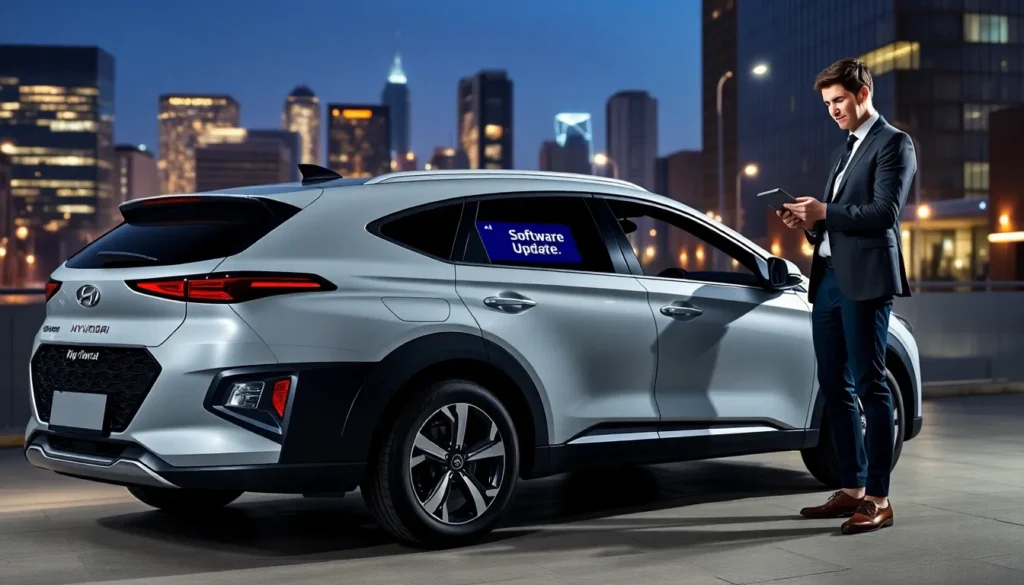Table of Contents
ToggleEver thought your car could be smarter than a smartphone? Well, with Hyundai software updates, it just might be. Keeping your vehicle’s software up to date isn’t just a quirky tech trend: it’s a necessity for ensuring your ride is as smooth as possible. In this text, we’ll jump into the nitty-gritty of Hyundai software updates, why they’re crucial, and how to make sure your car doesn’t fall behind in the tech race. Fasten your seatbelt: we’re going on a ride through the digital landscape of Hyundai’s vehicles.
Understanding Hyundai Software Updates

Hyundai software updates refer to the process of enhancing or fixing the software that runs various systems in Hyundai vehicles. These updates can improve navigation systems, infotainment features, safety functionalities, and various mechanical components. Just like your computer or smartphone, cars today rely on software to perform optimally and to provide drivers with cutting-edge technology.
Typically, Hyundai releases software updates to address bugs, introduce new features, or enhance existing functionalities. They can be downloaded directly to the vehicle via Wi-Fi or USB, making it as easy as upgrading your apps. Most of the time, these updates can improve the overall driving experience significantly, enhancing everything from your car’s performance to its entertainment features.
Importance of Software Updates for Vehicles
Software updates for vehicles are not just a luxury: they are essential for several reasons. Safety first. In many cases, updates can fix critical issues that might compromise the vehicle’s safety systems. Imagine a scenario where a software glitch could interfere with braking assist or lane-keeping functionalities. No thanks.
Also, software updates can unlock enhanced features that improve user experience. Get new navigation maps, improved voice recognition features, or even fun little updates that make your car feel fresh and modern. In today’s tech-driven world, keeping software current also means ensuring compatibility with mobile devices and apps, allowing for seamless integration.
Overall, staying updated isn’t just about fixing bugs: it’s about keeping your ride as efficient and enjoyable as possible.
How to Check for Updates on Your Hyundai
Checking for software updates on a Hyundai vehicle is fairly straightforward. First, ensure your car is parked somewhere safe. Start the vehicle and head to the infotainment system. Most Hyundai models have a built-in feature that allows users to check for updates. Here’s how it usually goes:
- Navigate to the ‘Settings’ menu.
- Go to the ‘Software Update’ option.
- Select ‘Check for Updates’.
If an update is available, instructions will pop up to guide users through the process. For some models, you may need to connect your car to Wi-Fi for a smooth download. If your vehicle’s software is up to date, the system will let you know, so no need to worry.
Also, you can also visit the Hyundai website or use the MyHyundai app to check for available updates.
Step-by-Step Guide to Updating Your Hyundai Software
Updating Hyundai software is a breeze once you know the steps. Here’s a comprehensive guide to make the process as smooth as possible:
Step 1: Backup Important Data
Before doing any updates, it’s wise to back up your infotainment settings and any saved navigation favorites (if applicable). Losing your favorites could be a hassle.
Step 2: Connect to Wi-Fi
Ensure your Hyundai is connected to a strong and stable Wi-Fi network. If your model uses USB for updates, prep your USB drive formatted to FAT32.
Step 3: Navigate to Software Update
In the infotainment system, head to the ‘Settings’ > ‘Software Update’ section.
Step 4: Download the Update
Hit ‘Check for Updates’ and follow on-screen instructions to download the latest software version. Be patient: depending on the size, it could take some time.
Step 5: Install
After downloading, the system will prompt you to start the installation. Make sure not to turn off the vehicle during this process.
Step 6: Reboot
Once the installation completes, reboot the infotainment system if it doesn’t automatically.
And voila. Your Hyundai is now sporting the latest software, complete with fresh features and bug fixes.
Common Issues and Troubleshooting During Updates
Even though updating Hyundai software is relatively straightforward, users might run into some bumps along the road. Here are a few common issues and how to troubleshoot them:
Connectivity Problems
Sometimes Wi-Fi connections can be spotty. If an update isn’t downloading, check your connection, and consider moving closer to the router or switching to mobile data if supported.
Power Issues
Make sure your vehicle battery is adequately charged. An interrupted update due to a dead battery can cause issues. Ensure the vehicle is parked with the engine running or in accessory mode during updates.
Installation Errors
If an installation fails, simply retry the update process. If it continues to fail, contact Hyundai customer support for assistance. They might have specific solutions for your model.
These simple pointers can save a lot of time and frustration, ensuring a smooth update experience.
Future of Software Updates in Hyundai Vehicles
The landscape of software updates in vehicles is continually evolving, and Hyundai is at the forefront of this tech revolution. As automotive technology advances, software updates are expected to become even more integrated into the driving experience.
Future vehicles will likely feature over-the-air updates, enhancing features long after a vehicle leaves the showroom floor. This means vehicles could receive new capabilities akin to smartphones, allowing Hyundai car owners to enjoy more individualized experiences without needing to visit a service center. Expect features like enhanced autonomy, personalized driver settings, and state-of-the-art safety features all controllable via software adjustments.
This forward-thinking approach goes beyond mere updates: it shapes the entire future of automotive technologies, placing Hyundai miles ahead in innovation.




